A drive by Fox Lake on a sunny Saturday afternoon will yield a view of tree-lined shores, shimmering water and boats drifting leisurely along, many with fishing lines pulled taut behind them.
A popular fishing spot, Fox Lake may be a little too popular. In April 2017, Environment Yukon changed fishing regulations for the lake, reducing the daily catch and possession limits to four for grayling and pike and asking anglers to use barbless hooks. Most notably, it reduced the limit of lake trout — the creme de la creme of sports fish in the north — to one fish below 65 centimetres in length per angler. Similar reductions have been seen across easily-accessed lakes in the Yukon, including mandatory catch-and-release in seven lakes.
These rules are obviously not always popular, but they are necessary in these areas to preserve and protect the lake trout anglers prize so highly, says Robert Perry, the senior fisheries biologist for Environment Yukon.
“Lake trout populations throughout the Yukon are doing pretty well, overall,“ he said. “Our lakes are amazing and beautiful and predominantly healthy. The problem areas are those in close proximity to urban areas. We spend a lot of attention to to make sure those populations remain healthy. Retention bans and catch limits are to protect those populations and allow them to recover.”
Determining how many fish are in a lake is a complex process, but it starts by assessing the potential productivity of a lake, Perry says. Researchers analyze the water quality, which involves looking at the chemistry and available nutrients of the lake to determine how many fish of a given species it could theoretically host. This is not unlike pasture management, a technique used to determine how many animals can be grazed on a given piece of land.
“We look at that value and say ‘how many (lake trout) can this lake hold?’” Perry said.
Temperature is also an important factor, as lake trout do best in waters between 8-10 C, Perry said.
These estimates are based on a technique adopted from Ontario called Summer Profundal Index Netting (SPIN) surveys, which involves net-sampling populations, and angler surveys that ask anglers how many fish they caught, how big the fish were and how long the anglers spent fishing, Perry says.
Using these numbers, biologists can determine where and when to place limits on fishing, Perry says. For example, Frenchman Lake, where anglers must currently throw lake trout back, shares a similar productivity value to Dezadeash Lake, where anglers can keep two lake trout. Frenchman is 1,441 hectares in size with an average depth of 17 metres and Dezadeash is 8,250 hectares and with an average depth of 4 metres.
Angler surveys showed Frenchman is much more heavily fished than Dezadeash. Each hectare is fished for 3.2 hours over the course of the summer at Frenchman but the figure is only 29 minutes per hectare for Dezadeash. Despite the smaller size and more time spent on Frenchman Lake, only 0.03 lake trout were caught per hour, Perry says, versus 0.35 fish per hour on Dezadeash. That means if you spent a full eight-hour day fishing on Dezadeash, you’d be likely to catch three lake trout. To catch the same amount of fish on Frenchman, you would have to try for 100 hours.
“(The lakes) are similar in productivity and therefore should have similar lake trout numbers,” Perry said. “The major difference between the two water bodies is their respective sizes and average depths. Smaller lakes are more vulnerable to harvest pressure because they have less habitat and therefore less fish.”
Frenchman is estimated to have two lake trout per hectare. Dezadeash has about six, Perry said. The differences in the number of fish in both lakes — and, by extension, the reason for the retention ban at Frenchman — has largely to do with the overfishing of Frenchman.
“Fishing pressure is increasing on Frenchman Lake, above sustainable limits. The increased pressure has caused a decline in absolute fish numbers…. In contrast, Dezadeash harvest levels have remained at a sustainable limit. This has resulted in higher numbers of lake trout … and therefore good catch rates,” Perry says.
“The results support our conclusion that lake trout abundance in Frenchman Lake is lower than it should be.”
Similar population results and circumstances exist for the other six Yukon lakes currently closed to lake trout retention, Perry said.
Lake trout are a sleek, powerful fish, varying in colour from black to light green. They prefer cold water and can grow to weigh between 20 and 30 pounds. They grow slowly, says Perry, reaching sexual maturity between nine to 12 years of age. By contrast, pike reach sexual maturity at three to four years of age, burbot at two and whitefish between three and six. Moreover, larger older trout — those 1,000 mm or longer — produced an average of 27,000 eggs, 13.5 times more than lake trout 500 mm in length, who typically produce 2,000 eggs. Females lay eggs only once every three years.
This slow growth, late maturity and spaced-out reproduction make these fish particularly vulnerable to overfishing, Perry says.
“So when you catch one of those bigger, older fish, you might have 35 years of growth (on the line),” he says. “The Yukon is not southern Canada, our lakes aren’t as productive — it’s important people manage their expectations.”
In this way, lake trout are similar to prized game mammals like thinhorn sheep, which are slow to mature, occupy a specific habitat, and are subject to strict hunting limits.
“Anglers tend not to really see it like that, because it’s a fish, but (lake trout) are something as spectacular as a grizzly,” Perry says. “I think they’re in the same ball park.”
Contact Lori Garrison at lori.garrison@yukon-news.com
